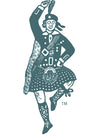When you hear the word ‘tartan’ what immediately springs to mind? Is it kilts? A bagpiper? A cosy throw? Or even a tin of shortbread? Whatever image you conjure up, the common theme is sure to be something associated with Scotland.
Today, tartan is universally associated with Scotland and traditional Scottish clothing, largely because it is used to make Highland kilts, blankets and scarves.
WHAT IS TARTAN?
Tartan is a woollen fabric featuring a distinctive criss-crossed pattern with contrasting colours. Each type of tartan has its own distinct pattern, or ‘sett’.
Some people think the word ‘tartan’ comes from the French ‘tiretaine’ - a patterned, woven material. Others believe it might derive from the Scottish Gaelic ‘breacan’ which describes a cloth of many colours.
To slightly confuse matters, in the U.S. and Canada tartan is often called ‘plaid’. We know this word comes from the Scottish Gaelic ‘plaide’, meaning blanket. However, in Scotland, a plaid is a large length of tartan fabric which can be worn as a kilt or a large shawl.
But whether you call it tartan or plaid, Wikipedia estimates there to be between “3,500 to 7,000 different tartans in existence with around 150 new designs being created every year”: testament to the enduring popularity of tartan.
A BRIEF HISTORY OF TARTAN
Tartan has a surprisingly ancient history. The earliest known tartan in Scotland – known as the Falkirk tartan – dates to around 250AD, during the Roman occupation. And even older examples of tartan-like cloth have been found in other parts of the world dating to around 3000 BC.
Early Scottish tartans were made of undyed wool, using natural white and brown-coloured sheep’s wool. Weavers would later use the natural dyes that they could source in their local area to create different colours.
In the early 1700s tartan became such a feared symbol of rebellious Highland clansmen who supported Bonnie Prince Charlie that after the Battle of Culloden in 1746, the English passed a law banning anyone from wearing it. However, tartan was still worn by government troops: the ‘Black Watch’ force, comprising six Scottish clans which patrolled the Highlands that all wore the same tartan. This distinctive tartan, a mix of dark blue and green, eventually became known as Black Watch tartan – one of the most popular tartans today.
EVOLUTION OF THE KILT
Before 1600, Highlander men commonly wore a knee length thick wool garment over a loose shirt. Over the next century, this was gradually replaced by the ‘belted plaid’ and the ‘little kilt’.
The belted plaid used long lengths (6 ‘ells’ - or around 7 metres) of double tartan cloth wrapped around the body and belted at the waist. The lower part formed a loose-gathered ‘kilt’ and the top half was worn over one shoulder with a brooch to pin it in place.
This is what Mel Gibson wore in the movie ‘Braveheart’ – although it is wildly inaccurate. William Wallace fought the English in the 13th century, long before tartan and kilts appeared.
The ‘little kilt’ comprised single tartan cloth, with sewn pleats at the back and plain overlapping pieces at the front. This is the forerunner of the modern kilt.
And thanks to the Scottish writer Sir Walter Scott, who organised a pageant for the newly crowned King George IV of Scotland in 1822, the tartan kilt soon became a key part of Scottish national identity. During the visit, King George wore a bespoke highland outfit in bright red tartan, later known as Royal Stuart, or Royal Stewart. This is now the official tartan of Queen Elizabeth II.
Tartan was given a further royal boost twenty odd years later, when Queen Victoria and Prince Albert bought Balmoral castle in 1848. The refurbished interiors featured Royal Stewart tartan for curtains and upholstery and green Hunting Stewart for the carpets. The royal family often wore Highland dress and fuelled a craze for all things tartan.
CLAN TARTANS
Although today Scottish clans (ancient family groups) are associated with their own specific tartans, there is no hard evidence of ‘clan tartans’ before 1815, when official tartan clans began to be registered by the Highland Society of London.
The clan system doesn’t exist today but there are many clan societies and gatherings which are attended by their descendants from all over the world. It is reckoned that there are over 25 million people worldwide who can claim Scottish ancestry.
There are also registered tartans for Irish clans and other tartans for Celtic nations such as Wales, Cornwall and the Isle of Man.
DIFFERENT TYPES OF TARTAN
Today we can classify tartans into one of five groups: modern, ancient, dress, muted and hunting:
- Ancient tartan has softer tones, designed to look ‘aged’ or faded. Here at Highland Store these tartans are listed as ‘Antique’
- Muted tartan (or weathered tartan) was first produced in the 1970s and is a shade somewhere between modern and ancient. They are designed to be a close match to the colours produced with traditional natural dyes.
- Hunting tartans were conceived by the Victorians and are made with subdued colours like dark blues, browns and greens.
WEARING TARTAN TODAY
Scots will proudly wear Highland dress for formal occasions such as weddings, award ceremonies or sporting events such as football & rugby matches and the Highland Games. [Our Guide to Scottish Traditions]
Although there is nothing to stop you wearing any tartan, the concept of ‘universal’ tartans has developed over time to mean patterns that anyone is free to wear.
Tartan seemingly never goes out of fashion. In the 1970s tartan was adopted by the punks and in subsequent decades it has featured in the collections of fashion designers such as Vivienne Westwood, Alexander McQueen, and Jean Paul Gaultier.



